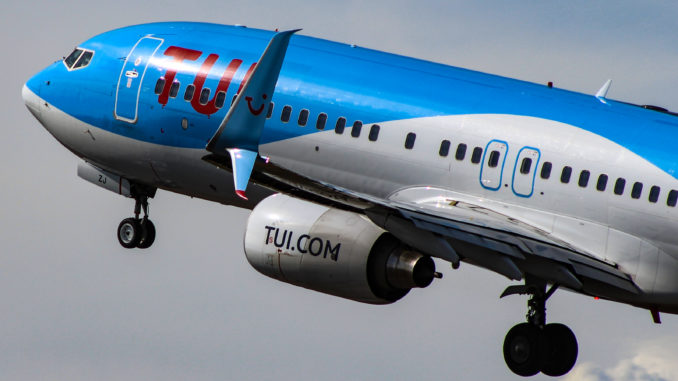
According to a special bulletin from the Air Accidents Investigation Branch (AAIB) both pilots of a TUI Boeing 737-800 failed to notice that the autothrottle had disengaged during take-off from Bristol Airport (BRS/EGGD).
The pilots were operating a flight using a TUI Airways UK Boeing 737-800 (G-FDZS) from Bristol to Las Palmas.
During departure everything was set up in accordance with the Standard Operating Procedures (SOPs) for the aircraft and airline including setting the autothrottle switch to ARM on the Mode Control Panel (MCP).
The aircraft left the stand at 10:41 and taxied to Runway 09 at Bristol Airport. At 11:04 the flight was cleared to take-off and the Captain, who was undergoing captain line training, handed control of the aircraft to the training captain in there right seat who was to be the Pilot Flying (PF) for that sector.
In accordance with SOPs the Captain, (pilot not flying), advanced the throttles to 40% and after they had stabilised engaged TO/GA mode which engages the autothrottle to N-Mode to the preset take-off thrust.
It was at this point that the autothrottle disengaged emitting the associated warning sound and almost immediately the Captain re-engaged the switch while the pilot flying advanced the throttles before releasing them.
The autothrottle reengagement though did not take control of the thrust levers which still required manual control and as a result the throttles did not go to the required thrust setting of 92.8% N1, in fact only 84.5% N1 was achieved resulting in a significant reduction in aircraft performance which saw the aircraft rotating with just 260 metres of runway remaining and passing the threshold of Runway 27 at a height of just 10ft.
Despite the close call, the pilots decided to continue the flight to Las Palmas which operated normally except for several attempts to engage the autothrottle system and subsequent disengagements.
Data from the flight also shows that due to the thrust not being rectified until until the aircraft had reached 900ft above the ground, the A road outside Bristol Airport at the end of Runway 09, the A38, was crossed at just 100ft.
Interrogation of the flight systems shows that the likely cause of the disengagement was a fault with the servo which controls the No1 throttle levers.
Talking about why the pilots may have missed the fact that the autothrottle was not engaged the AAIB report says: “It is well known that humans are poor at detecting acceleration rates and recognising that their takeoff run is not matching the calculated performance. Performance issues can be insidious and invisible to the crew until very late in the takeoff roll. A previous report from the AAIB covered the reasons for this in detail1. However, it is very unlikely that any crew will recognise there is an issue until they approach the end of the runway, and few crews then select an increase in power to try and mitigate their performance issues.”
Several recomendations were made including that the “Civil Aviation Authority encourage all UK Air Operator Certificate holders to implement into their flight data monitoring programme algorithms to detect the precursors relevant to the monitoring of takeoff performance detailed in the European Operators Flight Data Monitoring Document, Guidance for the implementation of flight data monitoring precursors.”
A spokesperson for TUI responded to the bulletin saying: “We have worked closely with the authorities to provide all available information. The AAIB recommendations and learnings resulting from this take-off will support the whole aviation sector and other airlines. The safety of our passengers and crew is always our highest priority.”




